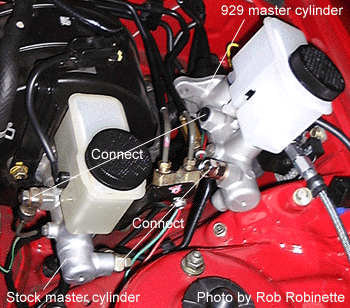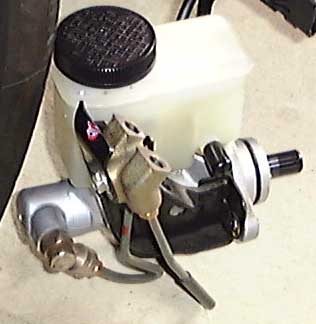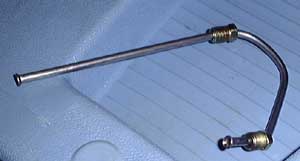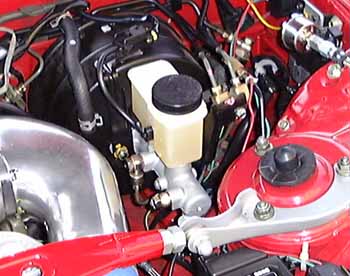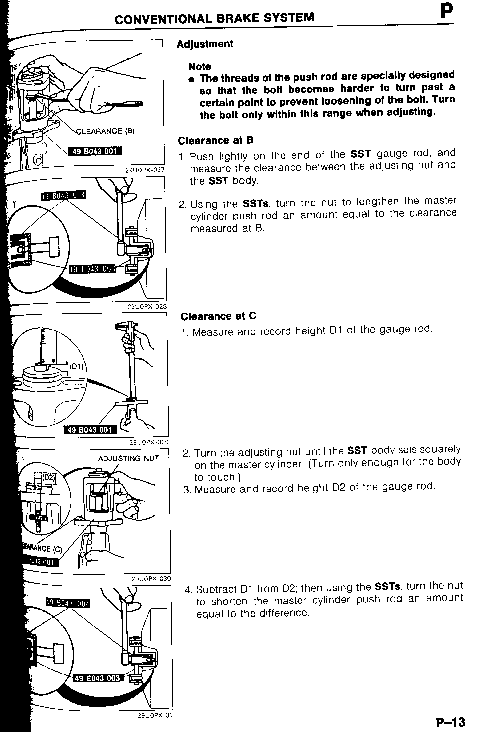929 Master Cylinder Install (for big brakes)
By Rob Robinette
Why would you need to upgrade the master cylinder?
When you upgrade to larger brake calipers your brake pedal movement may increase because more brake fluid has to be moved to power the bigger (or more) pistons. Upgrading to the Mazda 929's master cylinder (MC) can bring the pedal movement and feel back to stock (or better than stock). The stock master cylinder is 15/16" in diameter, the 929's is 1" in diameter and about 1/4" longer. That 1/16 of an inch larger piston pushes quite a bit more fluid. After I did this mod my brake pedal was firmer and it required less pedal effort to lock the brakes. I'm very happy with this upgrade.
The only difficult part of this mod is the fabrication of two 12 inch lengths of brake line which can be done pretty easily if you have a pipe cutter and pipe double-flare tool. You can always take the 929 master cylinder to a brake shop and have them fabricate and install the brake lines. You can do everything else and save some cash.
Master cylinder comparison. The rear brake line connector on the 929 MC is designed for a flare fitting, not a banjo bolt like the RX-7 MC.
What You Need
A 93 Mazda 929 master cylinder part # HG31-43-400G (ABS version) - I got mine from Jeff Haas Mazda for $170 (that's a 25% discount for ordering from their 800 number: 800 233-2991). Pep boys wanted $214 for it. Mazda Competition Parts will sell it for $135 if you are a qualified racer.
You also need a 929 MC metric flare nut, the MC comes with the banjo bolt, but you need a flare nut for the rear MC brake line connector.
Also pick up two 12 inch lengths of 3/16 inch brake line ($4 auto parts store), a pipe cutter ($7 Home Depot), pipe double flare tool ($40 Pep Boys, do not use a single flare tool-it's not safe), 10mm flare nut wrench ($4 auto parts store--if you try to use a standard 10mm wrench you will round off the fittings)
Workshop Manual - Master Cylinder Removal/Installation
Removing the Master Cylinder
Warning
Do not attempt this modification yourself unless you are a very competent mechanic. Two short brake lines will have to be fabricated and a single point failure in the brake system will result in the total loss of brakes and possible damage/injury/death! A brake shop can fabricate the brake line and hook it up to the new master cylinder.
Before you remove any of the brake fittings, carefully clean all around them, so that dirt can't get into the system as the fittings are opened.
Remove the stock MC
Start by putting some rags below the master cylinder (hydraulic fluid will bubble and peel your paint very quickly). I recommend getting a pack of various size vacuum plugs for this purpose. I put plugs on each of the two brake lines and one on the hydraulic clutch connection to prevent excess fluid drippage. Use a 10mm flare nut wrench which is the SST (Special Service Tool) the RX-7 Workshop Manual calls for to loosen the brake lines that go into the double brass fitting next to the filler cap (item C in the first diagram above). I highly recommend you buy a $4 10mm flare nut wrench (the SST mentioned above). It has a wider jaw to keep you from rounding off the nuts and its length will help you torque the brake fittings properly (it's hard to do with a 5 inch long 10mm wrench). By disconnecting the brake at the brass double fitting, very little fluid will drip out. I put vacuum hose caps on the brake lines once I got them loose. Remove the two nuts that hold the MC to the brake vacuum chamber. Remove the large vacuum line running to the vacuum chamber to relieve the vacuum pressure and remove the MC. If you don't release the vacuum you will have trouble getting the MC out.
You'll have to swap the master cylinders' reservoirs because the 929's doesn't have an hydraulic clutch connection. Remove the Phillips head screw below the reservoir and pop off both reservoirs and then swap them. Use a little hydraulic fluid on the rubber seals to make the installation of the reservoir easier. Reinstall the Phillips head screw to secure the reservoir.
The 929 MC has a fitting for one of the two brake lines on the wrong side (engine side, rather than towards the fender). The rear brake line needs a metric flare nut, the other already has a banjo bolt with a flare fitting installed.
The new front brake line
Both brake lines on the MC will have to be replaced. I bought two prefabricated, 12 inch long 3/16 inch brake pipes, cut off one end, removed the flare fittings, put on metric flare fittings, bent them over a 2 x 4 railing to get a nice 180 degree bend, cut it to fit with a pipe cutter, put the other metric flare fitting on and double-flared the new pipe. See Photo. See the Flare a Brake Line How To for instructions on how to double flare a brake line. The rear line runs straight out from the rear flare fitting a couple inches and bends down and under the MC, coming up to the brass junction block. Make sure the lines don't rub the MC or its support. Connect the new brake lines and torque the connectors to 113 to 190 inch pounds (10 to 15 foot pounds).

